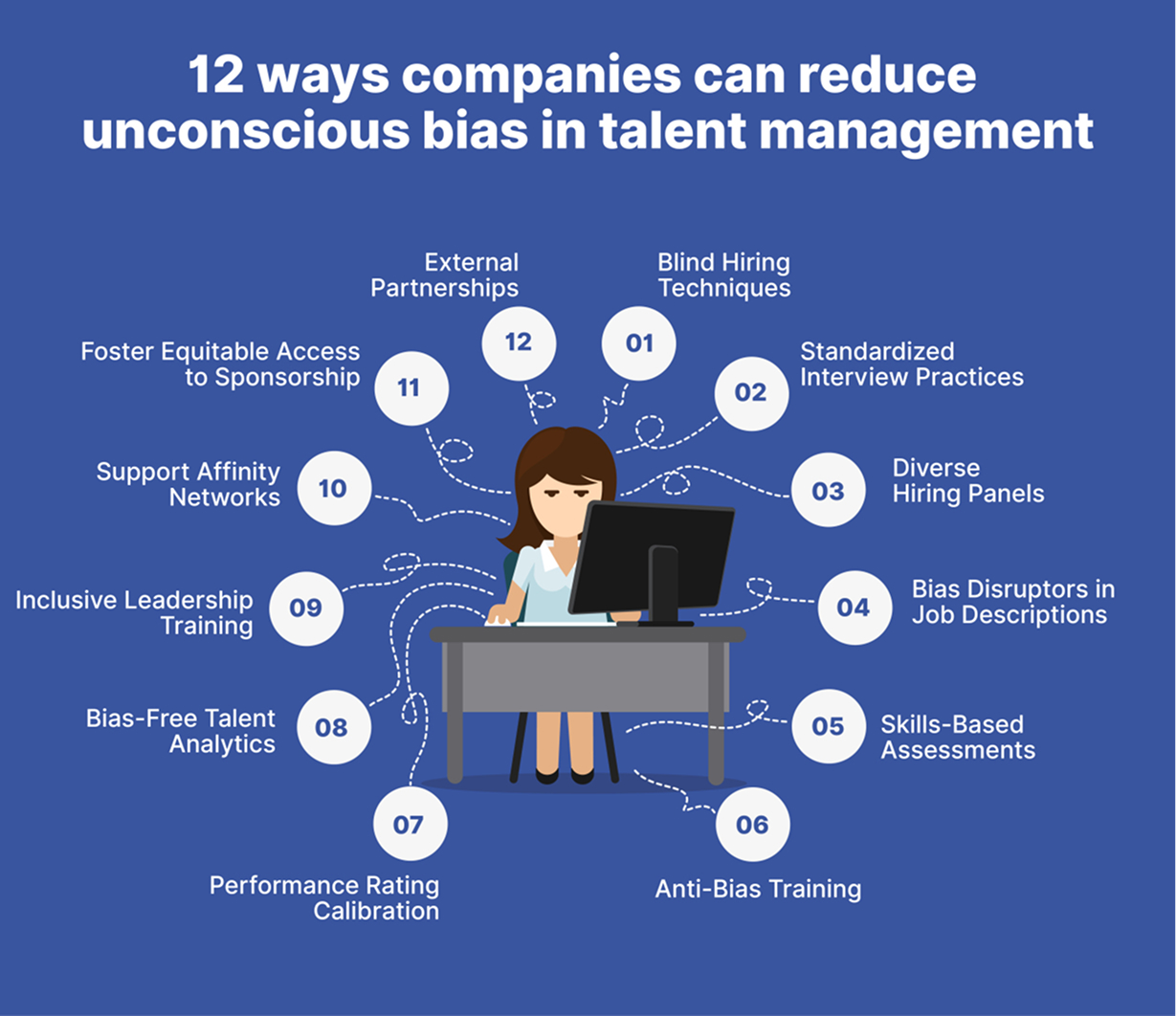
Unconscious biases influence every organization’s talent management, restricting diversity and equity. However, human resources departments can implement robust frameworks to eliminate partiality from hiring, promotions, compensation, and professional development. This article explores 12 bias mitigation techniques backed by organizational psychology research.
Unconscious biases encompass the embedded prejudices and stereotypes that involuntarily affect people’s attitudes and actions. When unaddressed, unconscious bias propagates discriminatory behaviors and creates inequitable, hostile, and non-inclusive work cultures.
Within talent management, unconscious biases manifest in:
Unconscious biases can negatively impact hiring and recruiting in the following ways:
Unconscious bias also impacts diversity in leadership and management roles:
To promote inclusive leadership and management, organizations can implement structured promotion criteria, formal sponsorship programs, egalitarian performance standards, and take risks on non-traditional leaders.
Various biases also enable pay gaps across different groups:
To promote pay equity, organizations must implement structured compensation frameworks, encourage salary negotiations, ensure pay transparency, and conduct regular pay audits.
Additional biases creep into performance evaluations:
To ensure equitable performance appraisals, structured evaluations, multiple assessors, and oversight for calibration are key.
Biases also impede access to development opportunities:
To facilitate inclusion, organizations should formalize mentoring and sponsorship, equitable work distribution, and work-life balance policies. Mitigating unconscious bias requires a multipronged strategy focused on systemic change. Isolated initiatives like standalone training often fail due to lack of reinforcement. HR professionals should collaborate with senior management to develop robust frameworks that promote sustainable equity.

1. Blind Hiring Techniques
Blind hiring techniques like redacting candidates' names and demographic information from resumes help reduce affinity bias during the screening process. Affinity bias causes managers to favor applicants who they perceive to be similar to themselves in terms of gender, ethnicity, age, or other attributes. By removing personal details from resumes and job applications, evaluators are able to focus solely on the skills, capabilities, qualifications, and potential cultural fit of each candidate. Techniques like using randomized or alphanumeric applicant IDs rather than names further enhance impartiality during resume screening.
Redacting names, photos, and demographic information allows evaluators to avoid unconsciously favoring candidates similar to themselves. This helps ensure that all applicants are given fair consideration based on merit alone during the initial resume screening process.
2. Standardized Interview Practices
Structuring and standardizing the interview process is another impactful way to minimize bias and partiality. HR should develop a standardized scorecard with weighted criteria that all interview panelists use to evaluate and rate candidates during the interview process.
By asking each applicant the same predetermined questions, in the same order, organizations can help prevent irrelevant personal factors and first impressions from unfairly impacting scoring and evaluations. Standardized interviews allow panelists to maintain focus solely on each candidate's skills, qualifications, and capability to succeed in the role, rather than unrelated preferences or unconscious bias.
3. Diverse Hiring Panels
Homogenous hiring panels often unintentionally demonstrate affinity bias by selecting candidates most similar to themselves. To counter this, HR should ensure that screening and interview panels feature cross-functional diversity in terms of gender, ethnicity, age, and professional backgrounds of panelists.
Including panelists from marginalized or underrepresented groups provides fresh perspectives that privileged decision makers may overlook. Varied lived experiences among panelists further enables effective evaluation of how candidates demonstrate cultural competence, empathy, communication skills, and adaptability during the hiring process.
4. Bias Disruptors in Job Descriptions
Gendered, ambiguous, or overly competitive language in job descriptions can deter highly qualified candidates from applying. To prevent this, HR should stress required skills, capabilities, and qualifications in job descriptions rather than subjective qualities like “rockstar” or “ninja”.
HR can also reduce bias by highlighting opportunities for remote work or flexibility to signal that traditional norms around strictly onsite work or long hours won’t impede otherwise qualified applicants from advancing.
5. Skills-Based Assessments
Rather than relying solely on resumes and unstructured interviews, HR can leverage skills-based assessments to objectively evaluate candidates' capabilities for the specific role. Skills assessments provide hiring teams with a predictive view of candidates’ potential on-the-job effectiveness.
Relevant assessments may include work samples, role play exercises, and job knowledge tests tailored to the open position. By directly testing competence, skills-based assessments help organizations select the objectively strongest candidates based on merit rather than subjective evaluations of culture fit or unconscious bias.
6. Anti-Bias Training
Ongoing anti-bias training sessions, as opposed to one-time training, are more impactful for mitigating unconscious biases over time. Organizations should implement regular bias disruption workshops, forums, or discussions to continually reinforce inclusive mindsets and behaviors.
These sessions could cover specific topics like recognizing microaggressions, deploying inclusive leadership techniques, minimizing harmful stereotypes about marginalized groups, and understanding intersectionality. The sessions should incorporate interactive elements like small group discussions, reflective writing prompts, debrief conversations, and role playing real-world scenarios.
Through repetitive, immersive and conversations-based anti-bias content, participants can expand their awareness of implicit biases and learn constructive ways to challenge prejudices. Equipped with these tools, employees at all levels are more conscious about ensuring equitable treatment in their day-to-day interactions.
7. Performance Rating Calibration
When evaluating members of their team, managers frequently demonstrate similarity bias, an affinity toward those who match their own working styles, communication preferences and personality traits. This leads managers to unconsciously inflate performance scores for employees most similar to themselves due to overvaluing behaviors they personally identify with.
To mitigate this bias, HR departments can introduce calibration norms for performance ratings across teams. Calibration involves managers meeting to compare their initial ratings and feedback for direct reports.
The goal is to expose any inconsistencies, gaps or patterns across high versus low scores given by specific raters. This process prompts managers to thoroughly reassess any outliers or questionable ratings to ensure all employees are being evaluated fairly on clear, standardized criteria versus a manager’s arbitrary preferences. Ongoing rating calibrations safeguard against unconscious similarity bias warping performance perceptions.
8. Bias-Free Talent Analytics
In addition to auditing and enhancing inclusive talent practices, HR should prioritize continuously monitoring key workforce analytics metrics segmented across gender, race, disability status and other diversity dimensions. Given unconscious bias tendency permeates most talent decisions, analyzing granular data is crucial for identifying instances where bias may be negatively impacting equitable access to opportunities and advancement for marginalized groups.
Relevant talent metrics to closely track include: applicant conversion rates by demographic group, compensation and pay equity ratios controlling for role and performance, relative promotion rates and velocity, employee engagement scores, sentiment toward inclusion, and regrettable turnover linked to belonging or advancement barriers faced by marginalized talent.
Any concerning or consistent demographic disparities in outcomes merit deeper investigation into root causes, enabling HR to promptly diagnose inclusion gaps and implement appropriate anti-bias remedies. Committing to robust, bias-free analytics practices fuels data-driven inclusion gains.
9. Inclusive Leadership Training
Lack of psychological safety and trust in organizational cultures often prevents marginalized employees from fully contributing ideas, highlighting concerns or bringing their authentic selves to work. To cultivate more welcoming team environments for diverse talent, HR can develop and scale customized inclusive leadership training for managerial staff. Curriculums should equip leaders to minimize microaggressions, counter stereotypes through local role modelling, nurture psychological safety via trust-building practices and actively solicit novel input from introverted or reluctant employees.
Additional inclusive leadership techniques might encompass tactics for giving equitable air time to women or minority team members in meetings, exhibiting empathy and curiosity when employees share sensitive identity-related experiences, or transparently discussing representation goals managers are accountable for within their teams. The bottom-line emphasises building leader capability in fostering ‘speak up’ cultures where everyone’s voices are structurally included.
10. Support Affinity Networks
Affinity networks bring together groups of employees with a shared identity, background or demographic status, such as generational networks, Women’s groups, Black employee networks, Pride groups for LGBTQ+ individuals or disability networks. These communities provide invaluable spaces for bonding over common experiences, finding mentors, leveraging insider knowledge for navigating barriers and garnering senior stakeholder support for inclusive improvements.
Given their considerable impact on attracting and engaging diverse talent, HR teams should actively assist affinity networks in forming through providing seed funding for launch events and operational budgets for ongoing activities. HR can additionally help networks coordinate 1-1 connections with senior executive sponsors and provide platforms for groups to share member voices across the organization. Positioning affinity group participation as a formal leadership development opportunity spotlights the value diverse talent brings to communities.
11. Foster Equitable Access to Sponsorship
Due to fewer close relationships with influential leaders, marginalized employees often lack dedicated sponsors who actively advocate for their placement onto career-accelerating assignments, consideration for promotions or visibility to executive decision-makers. This systemic sponsorship disparity compounds over time, entrenching representation imbalances into leadership ranks.
To promote equitable access to this make-or-break career support, HR can facilitate formal inclusive sponsorship initiatives by strategically matching high-potential individuals from underrepresented groups with executive mentors based on development needs and sponsor backgrounds. Program architects should also continually track and compare sponsorship program participation rates across gender, race and other demographics to address any emerging disparities in who gains access to coveted sponsor support.
12. External Partnerships
Forming external partnerships with non-profit organizations or specialized consulting firms focused on diversity, equity and inclusion provides helpful outside expertise for accelerating workplace culture transformations. Relevant groups like CEO Action for Diversity & Inclusion, Catalyst Workplaces That Work for Women, Disability: IN or INvolve reinforce leading inclusion practices.
These partnerships offer companies benchmarking assessments of current inclusion maturity including employee survey diagnostics. Partners supply proven frameworks, anti-bias training content, proprietary pipeline research on diverse talent and campus recruiting best practices. Tapping external guidance powers companies to fast-track more advanced and evidence-based inclusion capabilities internally.
Unaddressed unconscious biases create toxic, non-inclusive cultures that directly impact retention and innovation. However, implementing the appropriate combination of anti-bias initiatives promotes equity across the employee lifecycle.
Ongoing measurement enables HR managers to refine strategies in response to changing needs. While achieving bias-free talent management requires dedication, inclusive organizations ultimately gain significant competitive and cultural advantages.

CredBadge™ is a proprietary, secure, digital badging platform that provides for seamless authentication and verification of credentials across digital media worldwide.
CredBadge™ powered credentials ensure that professionals can showcase and verify their qualifications and credentials across all digital platforms, and at any time, across the planet.

Please enter the License Number/Unique Credential Code of the certificant. Results will be displayed if the person holds an active credential from TMI.